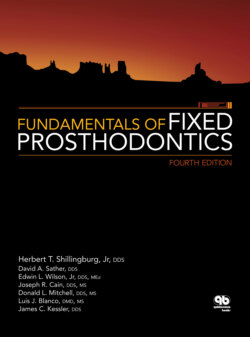Читать книгу Fundamentals of Fixed Prosthodontics - James C. Kessler - Страница 68
Anterior guidance
ОглавлениеThe influence of the TMJ on the occlusal scheme has been noted. The use of lateral interocclusal records in the setting of the condylar guides enables transfer of some of the influence from the TMJ to the semi-adjustable articulator. The influence of the incisors and canines (ie, anterior guidance) on the occlusion during excursive movements must also be taken into account.6,7
The guidance given to mandibular movements by the anterior teeth can be recorded using either acrylic resin or a lightcured material such as Triad (Dentsply) and made part of the setting of the articulator (Fig 5-33). Anterior guidance can, in effect, be transferred from the teeth to the incisal guide block of the articulator. If crowns restoring the lingual contours of the anterior teeth are to be placed, it is extremely important that the anterior guidance be registered on the articulator. If this is not done, the lingual contours or length of the restorations produced may not provide anterior guidance.
The mounted casts are examined on the articulator to assess the anterior guidance. If there are nonworking interferences on the casts, they are removed to enable the articulator to move freely while maintaining contact between the anterior teeth. The anterior guidance is examined to determine its adequacy. If it is not adequate because of wear, fracture, or missing teeth, it is restored to an optimum form with inlay wax or denture teeth on the cast.
The acrylic incisal block is replaced on the articulator with the dovetail incisal block (Whip Mix). The block is positioned so that the incisal guide, with the round end down, is 2 to 3 mm posterior to the tip of the retaining screw (Fig 5-34). The round end of the incisal guide pin and the functioning surfaces of the anterior teeth are lubricated with petrolatum. The interior surface of the dovetail block is also coated. Onehalf scoop of tray acrylic resin is mixed in a paper cup. While it still flows freely, a small amount is placed in the interior of the block (Fig 5-35). The material is allowed to acquire some body before proceeding.
Fig 5-36 The guide pin is closed into the soft acrylic resin.
Fig 5-37 The articulator is moved through all excursions.
Fig 5-38 An anterior guidance record has been formed in the dovetail incisal block.
The articulator is closed into full occlusion so that the guide pin penetrates into the soft tray resin (Fig 5-36). The articulator is moved repeatedly through all the mandibular movements, making sure that the anterior teeth remain in contact at all times (Fig 5-37). The tip of the incisal guide pin molds the acrylic resin to conform to the various movements. Movement of the articulator through all the excursions continues until the tray resin has polymerized.
Excess resin is trimmed off after it has polymerized. The tip of the guide pin has acted as a stylus in forming a registration of the anterior guidance (Fig 5-38). It will now be possible to duplicate the influence of the anterior teeth on the movements of the casts, even if the anterior teeth are prepared and the incisal edges shortened.
Fig 5-39 The components of a Slidematic facebow are (top to bottom) a reference plane indicator, the bite fork assembly, and the facebow with pointer.
Fig 5-40 A reference point is marked 43 mm above the incisal edges of the maxillary teeth.
Fig 5-41 The thumbscrew is tightened to attach the bite fork assembly to the underside of the facebow.
